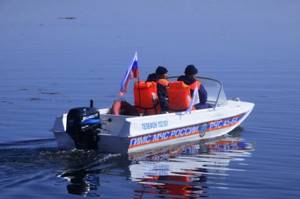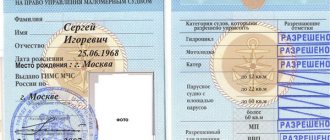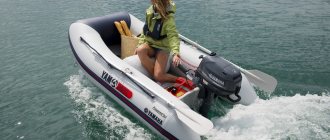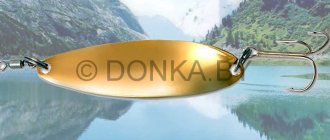Is it necessary to register PVC boats?
Since 2021, new rules for registering small-size vessels, which include PVC inflatable boats, have been in effect on the territory of the Russian Federation. Note that it does not matter what material the watercraft is made of - wood, metal, PVC, plastic and others. The key criterion for registration obligations is the technical characteristics of the boat. In addition, watercraft that are used for non-commercial purposes - tourism, hunting, fishing - are subject to registration.
A small vessel is considered to be a vessel whose length does not exceed 20 meters and can accommodate no more than 20 people on board. The weight of the craft should not exceed 200 kilograms, taking into account the weight of the motor. The engine power must be at least 8 kW (approximately 11 horsepower).
If your PVC boat meets the above criteria, it must be registered with the GIMS. Other watercraft are not subject to registration. To operate a registered vessel you will need the appropriate license. If the boat had an old registration, it is advisable to deregister it and register it again.
What should be on the boat?
We figured out whether a boat license is needed and in what cases. In conclusion, we present to the reader what must be on board his watercraft in accordance with the new legal requirements:
- Life jackets. The GIMS inspector will not “forgive” their absence. Moreover, vests are worn by everyone on the boat. Products must be red or orange in color, with reflective elements. The vest is also equipped with a whistle.
- Supply standards no longer apply to motor boats weighing up to 200 kg and engine power up to 10.88 hp. With. Of course, you should have a first aid kit, anchor and oars on board. But if this does not happen, the fine will still not be issued.
The presence of life jackets on board is important not for the GIMS inspector, but for the boat owner and his passengers. Therefore, you should not trust cheap (up to 1500 rubles) products. These are safety devices, but not life-saving devices. What are the differences?
The life jacket is designed so that when falling into the water, it will turn a person on his back and keep him afloat. Even if you don't know how to swim or lose consciousness. You shouldn't expect this from a safety vest. If a person does not know how to swim or is unconscious, his chances of being saved here are almost zero.
Summarize. Today you can drive a motor boat without having a license, without going through state registration of the vessel. But if you are the owner of a watercraft with a motor power of no more than 8 kW (or 10.88 hp). Otherwise, your boat is a small craft that must be registered. It is impossible to manage it without training, passing an exam, a medical examination and obtaining a license. Please also pay attention to the rules for placing numbers and the national flag on the sides of the boat. A state fee is charged for both registration and deregistration.
Documents required for boat registration
A PVC boat can be registered by both an individual and a legal entity. To register a watercraft, you must provide originals or certified copies of the following documents:
- Passport.
- Individual insurance number.
- Documents confirming ownership of the boat.
- Technical passport certified by the signature of the inspector.
- Documents confirming ownership of the outboard motor.
- Technical passport for the motor with the inspector’s signature.
Legal entities must have the following documents:
- Documents for state registration of an organization.
- Documents certifying that the watercraft is on the balance sheet of a legal entity.
- An order that assigns a boat to an employee of the company.
- Documents on the ownership of the vessel.
- Documents confirming ownership of the motor.
- Notarized papers for the right to operate a watercraft for an enterprise employee.
If the owner of the boat changes, the same list of documents is provided. In this case, the inspector checks the previous owner's ship ticket and whether the tax has been paid.
Boat registration process
Before registering a boat, you must obtain a driver's license for a watercraft. To do this you will have to perform the following steps:
- Go to your local GIMS office or a private organization that has a state license giving the right to train individuals in the operation of small boats.
- Complete a training course that lasts approximately 1.5 months.
- Pass an exam consisting of a theoretical and practical part.
- In 10 days you will receive a boat driving license.
After this, you can safely proceed to registering the watercraft, which consists of the following steps:
- Submit an application for registration in writing or electronically to the GIMS at your place of registration.
- Get a receipt from GIMS to pay the state fee.
- Bring the deflated boat and motor to an inspector for a technical inspection. For a fee, inspectors agree to carry out the exit procedure.
- Provide a technical inspection report and other documents.
- In three days you will receive a ship ticket. If there is a spare engine, data about it is also entered into the document.
- Mark the side numbers on both sides of the boat.
There are special requirements for the room. It should be resistant to water and contrast with the background of the boat. Letters and numbers should have a height of 150-200 mm. Paint or stickers may be used.
How to register a boat?

employees see grounds for suspending registration; the period may extend for a month. Therefore, do not put off the process for a long time so that you definitely have time to enjoy fishing on a powerful motorboat.
Parts of the registration can be completed through “State Services”.
Registration procedure for individuals:
- Collect documents: which confirm ownership of the boat and motor, the owner’s passport, registration certificate for the boat and motor, a receipt for payment of the state fee (1600 rubles + 200 rubles for issuing a ship’s ticket).
- Write a statement that the vessel needs to be included in the register of small boats.
- Deliver the boat to GIMS or invite an inspector to inspect the vessel on site.
- If successful, receive a ship's ticket, boat number and, with an undisguised smile and a clear conscience, set off for a big catch.
Legal entities need:
- Provide an extract from the UGRL; a certificate stating that the company has a registered watercraft on its balance sheet; an order from the authorities (copy) about who is appointed responsible for the use of the boat; receipt for payment of state duty.
- Get the boat inspected on site or at the State Inspection Service.
- Get a ship's ticket and boat number and just as happily set off to conquer distant waters.
The video shows how to put a number on a boat:
PVC boat number - step by step instructions
In what cases can registration be refused?
- Attentive GIMS employees discovered that the boat’s markings, which had been applied by the manufacturer, had been destroyed or changed.
- The documents you provided are reported stolen or lost.
- You did not come to GIMS on time.
Now you have a clear idea of which boats need to be registered and how to do it.
Share your experience in the comments and don’t forget to visit our store, which has a lot of interesting and useful things for fishermen and just lovers of water recreation!
Share link:
How to obtain a license to drive a small motor boat?
Obtaining a driver's license is directly related to the registration of the vessel in the State Inspectorate for Motor Vehicles, since the license must be provided upon registration. To complete the document, the following requirements must be met:
- Reach adulthood.
- Provide a written examination by a narcologist and psychotherapist.
- Take appropriate courses that provide documents for passing theoretical and practical exams.
Based on the results of the training, you will be issued a driver's license, which you must have with you when using a small boat in any body of water. The document gives the right to freely move through the waters of Russia. Rights must be stored in a waterproof case or sealed container to prevent damage.
When will you still have to register the boat with GIMS?
If one or both indicators (boat weight and engine power) exceed the established standards, registration of the boat is inevitable. Many boat owners are dissatisfied with the strict GIMS requirements for the weight of the vessel, but until 2021 the situation with registration was even tougher.
Registration was required for all motor boats with a carrying capacity over 220 kg. Passing driver's license exams, huge queues at the State Inspection Service, sticking numbers on rubber or PVC boards and passing technical inspections - many fishermen and hunters remember well what it was like. The current state of affairs is a step forward towards overcoming bureaucratic obstacles.
Is it possible to register a boat without documents?
In some cases, documents for a watercraft may be missing, for example, if the owner has lost them or damaged them. But even under such circumstances, registration is quite possible.
The procedure begins as standard, with the submission of an application to the local GIMS with a request to register the boat. The document must explain the current situation. The inspection will refuse the applicant and a certificate will be issued. This document will be the basis for filing a lawsuit in court.
The essence of the claim is a request to obtain ownership of the boat and subsequent registration of the vessel with the state inspection. It is worth considering that the plaintiff will have to pay tax.
If the claim is satisfied, the applicant must re-apply to GIMS with a court decision. After that, boat transport is registered on a general basis. But without a positive court decision, the process is impossible.
What documents are issued after registration?
The result of registering a boat will be the issuance of two side numbers, a registration certificate and a technical inspection report. The certificate is a document giving permission to use PVC boats in the inland waters of Russia.
A ship's ticket is a document confirming ownership of a watercraft. It contains the technical parameters of the small vessel, side numbers and information about passing technical inspection.
Violation of the above requirements entails administrative liability in the form of a fine in the amount of 500 to 1,500 rubles. If your boat weighs less than 200 kilograms with equipment and is equipped with a motor with a power of less than 10.8 horsepower, then the vessel does not need to be registered.
Which PVC inflatable boat needs to be registered?
A boat made of PVC material is compact and relatively light. For example: a 3-meter boat, whose weight is 50 kg, is a normal two-seater boat, for which a motor with a power of 3.3 - 5 hp is acceptable.
Larger boats and those designed specifically for motors are correspondingly heavier, but their weight is unlikely to reach 200 kg, so based on weight indicators, such a PVC watercraft will not be subject to registration.
But the main thing is the motor. The documents for the boat indicate the standards for the permissible engine. There are inflatable watercraft that allow the installation of powerful engines. For example, a three-seater inflatable motor boat can sail at speeds of up to 20 km/h, with a 10 hp motor.
It is also worth noting that there are electric motors and gasoline engines. The latter are produced with good power (for example: 30 hp) and do not require recharging, which allows you to be on the move for a long time. Such motors are in demand and are often used for inflatable floating devices.
Other rules regarding water transport also apply to such a boat:
- Acquiring a boating license.
- Registration in the register for small vessels.
- Maintenance is carried out every five years from the date of registration. An out-of-hours technical examination will be needed if you want to visit another region or after repairs. No technical inspection - a fine of 500-1000 rubles.











